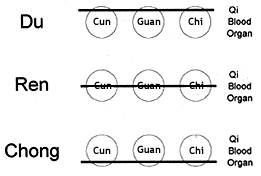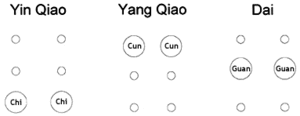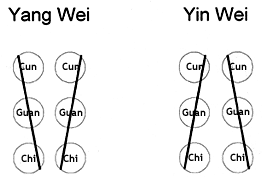This article is from an in-progress book called Neoclassical Pulse Diagnosis. It is the result of clinical application of classical passages. The message here is the encouragement of classical study and creating new possibilities for this medicine based on classical foundations.
The eight extra vessel pulses discussed by Li Shizhen and Wang Shu-he offer an effective method of diagnosis; it is odd they have fallen into non-use. Once the system is mastered, it takes five seconds at the most to determine which eight extra vessels are involved. Clinical strategies based on these findings give deep effects with minimal or no reactions. These pulse images can be accurately identified between practitioners, producing a higher degree of inter-rater reliability.
The eight extra vessels as a whole function as a container for the processes and structure of the human organism. There are three groupings of eight extra vessel pulses, providing three planes that help define a cube of space that is the dimensional field in which structure and function take place. In terms of pulse diagnosis, this context is not metaphorical: it is literal. The du, ren and chong channels define an x-axis. The yin qiao, yang qiao and dai channels define a y-axis. The yin wei and yang wei define a z-axis.
For standard pulse diagnosis, physiological processes are identified by pulse quality; anatomy is distinguished by the pulse position. For instance, a string-taut pulse may represent a process of qi. The position in which the finger feels the sensation defines the anatomical location. These two aspects of anatomy and physiology must take place within a three-dimensional field, and that is defined by the eight extra vessels. They show context and relationship as well as the active vessel that presents with a high degree of correlation to the symptom picture (roughly 85% accuracy).
The Images
The following pulse images do not necessarily indicate pathology in the vessel. They do indicate activity. The eight extra vessels are used by the body for compensation and adaptation. Their presence signals potentially useful interventions.
Group One: These pulses are long and string-taut. The du is most superficial; the ren is in the middle depth; and the chong is the deepest.

Group Two: The yin qiao is larger in the yin position (proximal - chi - cubit). The yang qiao is larger in the yang position (distal - cun - inch). The dai is larger in the middle (guan - bar) reflecting accumulation in the dai or belt channel.

Group Three: In the distal position, the yang wei vessel is displaced toward the yang (thumb -- radial) and the yin wei is displaced toward the yin (little finger - ulnar). This must be confirmed in the proximal position by opposite displacement so that a true diagonal line is present. The yin wei and yang wei pulse descriptions are the only discussion of vessel displacement in current English translations of classical and neoclassical literature.

Method
Place the fingers on one side as a unit (take care that the fingers are even and even pressure is used). Press until the first impulse hits the fingers. If all fingers are hit at once, it is a du, ren or chong pulse. If the index finger is hit first, it is a yang qiao pulse. If the middle finger is hit first, it is a dai pulse. If the ring finger is hit first, it is a yin qiao pulse. One must roll the index finger toward the radius for finding a yang wei pulse and toward the ulna to identify a yin wei pulse.
A Few Findings from Clinical Observation
- An eight extra vessel pulse is always present (this is because they show the volume distribution from position to position).
- Changes (if the image is changing, look for the dominant impression):
- When they are the same everywhere and consistently, it is a compelling reason to use an eight extra channel or the related herbs.
- They are an efficient method of record keeping.
- They show relationship of the various positions to each other, especially in terms of volume and force.
- Various eight extra vessels may be combined freely. It is particularly effective to open the dai in combination with the ren, du or chong.
- These pulse images may or may not reflect a pathology, especially if it is a du or ren pulse which may be considered ideal. However, treating the well person may require increasing adaptive capacity, which these vessels accomplish eloquently.
a. they can be different from side to side;
b. they can be different at varying depths of pressure;
c. they change when the amplitude is changing;
d. they change when treated.
Differing from qualities or positions, these images provide a backdrop of information that is not rendered available through "typical" pulse-taking methods.
Treatment Method
"Do not use these vessels on the first treatment" or "use the master and couple points together" are conventions that are not necessarily true in practice. In addition, there are no discussions in classical literature confirming the validity of these stylistic approaches.
One powerfully effective method is to needle the master point and then palpate the trajectory of the vessel for stagnations and accumulations, needling these areas. This clearly gives the signal to open a particular vessel. Merely opening a pair of master points regardless of sequence and then combining them with a myriad of other points does not necessarily give a clear message.
Herbal Information Related to the Eight Extra Vessels
Famous Qing Dynasty physician Ye Tian Shi [1690-1760 A.D.] was heavily involved in the wen bing (febrile disease) school development. He typically used small doses, and relied on foods for the basis of treatment. He also wrote about the herbs related to the eight extra vessels. Translations of this work can be found at bluepoppy.com and acupuncture.com. Each translation gives different herbs - make sure to check out both sites.
Many of Ye Tian Shi's medicinal selections contain animal products. Within the corpus of Chinese medicinals, animal products most powerfully generate jing. The eight extra vessels have a close relationship to jing, with their source in the kidneys and the ming men (gate of destiny).
Epilogue
These treatment concepts are intended for use in the context of a full diagnostic analysis and treatment plan. When used accordingly, this method has proven to be a very fruitful approach for a wide range of conditions.
- Li Shizhen. Lakeside Master's Study of the Pulse. Translated by Bob Flaws. Blue Poppy Press, 1998, pp57-60.
- Li ShiZhen. Pulse Diagnosis. Translated by Hoc Ku Huynh and Gary Siefert. Paradigm Press, 1985, pp54-57.
- Wang Shu-he. Mai Jing (Pulse Classic). Translated by Yang Shouzhong. Blue Poppy Press, 1997, pp54-58, 354-356.
Click here for previous articles by William Morris, DAOM, PhD, LAc.




